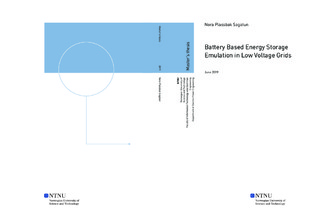| dc.description.abstract | Det elektriske nettet er i ferd med å moderniseres betydelig. En av de mest vesentlige trendene som kan modernisere kraftnettet er økt penetrasjon av distribuerte energiressurser. Distribuert generasjon forårsaker bidireksjonal kraftflyt og et desentralisert nettdesign. Integrasjonen av fornybare energikilder kommer med utfordringer, særlig når det gjelder planlegging og drift. Dette skyldes hovedsakelig de periodiske egenskapene ved fornybar energi, da de ofte er væravhengige. Integrasjonen av energilagringssystemer til lavspenningsnettet støtter bruken av fornybare energikilder.
Denne avhandlingen tar for seg netteverksintegrasjonen av et batteri energilagringssystem. Komponentene som er involvert i systemet beskrives teoretisk. Batteripakkene er designet for å møte de gitte kravene og testes gjennom simuleringer. En DC-DC omformer presenteres med en forklaring av indre strømløkkeregulering og ytre spenningsløkkeregulering. Batteriet og omformeren er implementert i MATLAB/Simulink, og resultatene presenteres. Videre forklares power hardware in the loop (PHIL) metoden. Batteripakken og DC-DC omformeren kombineres med en fysisk nettforbindelse ved bruk av en spenningskildeomformer ved å benytte PHIL-teknikken. Emuleringen av energilagringssystemet presenteres gjennom laboratorieresultatene.
Arbeidet i denne avhandlingen kan deles opp i tre hoveddeler: design, simulering og laboratoriearbeid. Designprosessen omfatter å utforme batterisystemet. Ulike batterityper er skissert, og litium-ionbatteriet er valgt. DC-DC omformerens komponenter er kalkulert, samt en regulering av strøm og spenningskontroll. Simuleringsprosessen gir resultatene fra batteriet og DC-DC omformeren modellert som en gjennomsnittsmodell. Laboratoriearbeidet implementerer PHIL strategien for å koble det emulerte batterilagringssystemer til fysisk laboratorieutstyr.
Simuleringsresultatene viste en fungerende kontrollstrategi for både spennings- og strømkontrollsløyfene. Spenningene og strømmene ut av batteripakken og DC-DC omformeren var akseptable. Dette muliggjorde videre laboratorietesting. Eksperimenter i laboratoriet viser at den simulerte og fysiske sensorspenningen oppførte seg identisk. Strømmen fra det fysiske utstyret opplevde et høyere støynivå enn den simulerte strømmen, noe som bunner i bruken av sensorer som er vurdert til mye høyere strømmer som fører til en sensitiv lavstrømsdrift. For å oppsummere, presenterer denne oppgaven en fungerende PHIL strategi for emulering av et energilagringssystem koblet til et lavspenningsnett. | |
| dc.description.abstract | The electrical grid is in the midst of a significant transition. One of the most important trends which modernizes the grid is the increased penetration of distributed energy resources. Distributed generation causes for bidirectional power flow and a decentralized grid design. The integration of renewable energy sources comes with challenges, especially in regards to planning and operation. The challenges are primarily due to the intermittent characteristics of renewables, as they are usually weather dependent. The integration of energy storage systems to the low voltage grid supports the use of renewable energy sources.
The work of this thesis concerns the grid integration of a battery energy storage system. The components involved in the system are described theoretically. Moreover, the battery pack is designed to fulfill the set requirements and tested computationally. A DC-DC converter is presented with an outline of the inner current control and outer voltage control. The battery and converter are implemented in the MATLAB/Simulink environment, and the results are presented. Further, the power hardware in the loop (PHIL) methodology is explained. The battery pack and DC-DC converter are combined with a physical grid connection using a physical voltage source converter by employing the PHIL technique. The emulation of the energy storage system is presented through the laboratory results.
The work of the thesis can be split up in three main parts: design, simulation, and laboratory work. The design process includes designing the battery storage system. Different battery types are outlined, and the lithium-ion battery is chosen. Further, the battery ratings are designed in correspondence with given requirements and rated data for the lithium-ion battery. The DC-DC converter components are designed, as well as the current and voltage control. The simulation process gives the results from the battery and DC-DC converter modeled as an average model. The laboratory work implements the power hardware in the loop methodology to connect the battery energy storage emulation to physical laboratory equipment.
The computational results showed a functioning control strategy for both the voltage and current control loops. The DC-DC converter and the battery provided acceptable voltage and current outputs, which enabled the further laboratory testing. From the laboratory work, the voltage and current responded quickly, and the simulated and physical sensor voltage behaved identically. The current from the physical equipment experienced a higher level of noise than the simulated current, due to the use of sensors rated to much higher currents, leading to a sensitive low current operation. To summarize, this thesis presents a functioning power hardware in the loop strategy for the emulation of an energy storage system connected to a low voltage grid. | |
